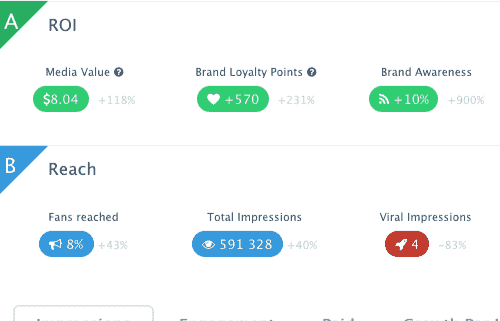Are you measuring the performance of your social media efforts? If so, what are you measuring?
Return on Investment (ROI) with social media may not turn into dollars or Euros immediately, but there’s still a value in getting traffic to your site and building a community online.
You should have a core set of metrics that you track on a regular basis, and social media tracking doesn’t have to that complex.
1. Conversions from Guest Posting
Writing a guest blog post on someone else’s site can be a source of immediate and ongoing traffic. But what happens to that traffic when it arrives?
If the traffic arrives and there is no engagement on your site, then there is less value than if somebody arrives and signs up to become an email subscriber, tries out your product or service or buys something.
You need to monitor this traffic and make sure that it is a providing a good return on investment. If you blog on a third-party site and get 500 visitors, 10% of them might sign up to your newsletter. With a larger size email list you can sell more products or services, get more money for ads in your newsletter and drive more traffic to your website.
Check ‘all referrals’ in Google Analytics and open up the details of the site where you guest posted:

We write on Social Media Examiner and you can see those conversion rates can be quite high. For example, from a post on Google Plus tools there were 16 new subscribers with a conversion rate of 14.02%.
You can also see we have a very low bounce rate: people come to the site, like the content and read more of it.
2. Conversions from your own blog content
What about the content you write yourself? Which content is useful and which is not? There may be some types of content that you write that get very high conversion rates, and some that get very poor results.
What counts as a conversion will vary from person to person, for example it could be a new email subscriber or it could be a sign up for a trial of your product or service.
If you select behavior -> site content -> landing pages in Google Analytics, you will see the conversion rate (if you have set up goals) for any of your blog posts.
Nice, eh? What if you have a low conversion rate on a post that’s getting a ton of traffic? Why not create an opt-in box that is specifically focussed on that piece of content?
3. Conversion from social media channels
Which social media channels are achieving the highest conversions for you? You can spend a lot of time on Facebook, Twitter, Google+ and other channels, but what’s the point if they are not helping you achieve your goals?
Of course, driving traffic to your site and converting that traffic might not be your only goal, but it should be one of your overall aims.
It’s important to keep track of what people are doing when they come to your site.

In the above image, you’ll see that our conversion rates are higher for Google+ and LinkedIn. You may also find that you get a lot more shares on Twitter than other networks, but that you get more conversions from visitors who arrive via other channels!
Like I said, it’s not all about conversions, but this is one area to watch.
4. Tracking Specific Shared Campaigns
What about sharing a deal out on LinkedIn, Google+, Twitter and Facebook? How do you track which conversions are coming from each channel?
Or what if you share a post on Facebook and, at the same time, set up an advertising campaign for the same promotion. Which one achieved the conversion? The post or the advertising campaign?
One way to start to unpick this is by using Google URL Builder which will tag additional parameters onto the link so you can view them within Google Analytics and see where your conversions are coming from.
There is a Chrome plugin for Google URL builder which makes it a little easier to create the URLs. You add it your browser and it will automatically pick up the URL of the page you are on. You then just fill out some basic details, and you can even create a shortened bit.ly link directly within the tool.
You can also create lists where you preconfigure items for your forms.

The parameters you fill out are as follows:
- Source: Where are you going to share out the link.
- Medium: Is this an ad, a Facebook post, an email?
- Term: Is this part of an AdWords campaign? If so what keywords does it relate to?
- Content: If you have multiple ads running for your keywords you can use this to differentiate between them.
- Campaign: If this is related to a particular campaign, enter the campaign details.
5. Tracking the value of awareness and engagement
When articles about us are published in the press, that is great for building brand awareness. The newspapers will tell us how many people read the paper so we’re meant to work out our reach based on this? C’mon, you know it’s impossible to really work out how many people have read or seen your article.
Yet, you’d still be happy to get your article in the hands of a big newspaper and if you could pay for an editorial piece you’d probably do that also.
The difference with social media is that it’s more measurable.
You can see on Facebook how many people have seen your content in their newsfeed (though they may not have read it). You can then see how many people engaged with your content, and how many site visits you get. You can then track these site visits to sales. Even if you don’t get the site visits you have increased awareness of your brand.
Jon Loomer recently advertised his great Facebook course on Facebook. He advertised to fans and to non-fans. Because the fans knew of him and trusted him, they bought it but the non-fans didn’t. So, Jon knows there is a lot of value in a fan.
Measure what reach you are getting, what engagement you are getting and how many visits you get back to your website.
What tools do you use?
There are many tools available, such as LeadSocial.
As the name suggests, it is all about measuring the value from social interactions and tracking that value to sales. As well as tracking engagement, it allows you to put a value against this engagement, based on what it would have cost if you had advertised on Facebook.

Then, when you’re posting, you can see how much it would have cost and start to measure the value to keep track of whether it’s going up or down.
All of this assumes that you have a relevant audience. If you simply ran a competition to give away an iPad, chances are your fans aren’t that relevant, so they won’t be engaging too much anyway.
Leadsocial also identifies your most loyal fans. These are the ones that are more likely to buy from you so it’s worth tracking them. If you know who they are, you can do extra promotion just for them (e.g. advertise on Facebook and target the ads directly to this group).
So, think about the value you get from social media channels and measure how much it is worth: this is invaluable information.
Summary
Social Media activity is measurable and, because it’s online, it’s a lot more measurable than other forms of traditional advertising. For example, how do you measure the value of a billboard? Do you calculate how many people drive or walk by and work out a value based on this?
At least with social media you can know how many people had the chance to see your update, and then you can see who actually engaged with it and even who came to your website and took some action.
So let’s start measuring!
Final Thoughts
This article is not the ultimate guide to social media tracking; there is more. But I hope there is enough here to get you thinking about taking some action. We encourage you to make a start, so here are 3 options for you now:
1. Comment below – Tell us we’re wrong or tell us we’re right!
2. Share this post – Let’s get other people involved.
3. Implement some suggestions and come back and let us know how you are getting on.
Thanks!
Ian



